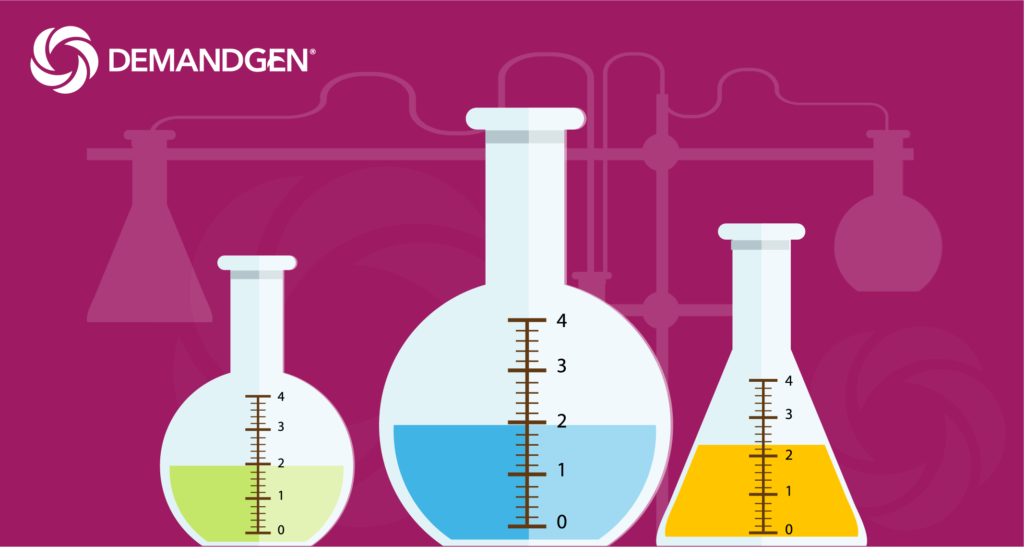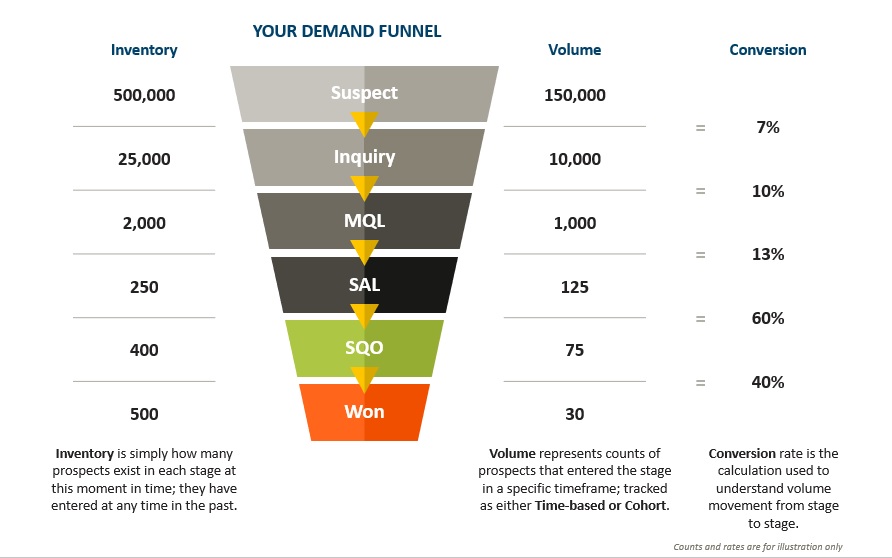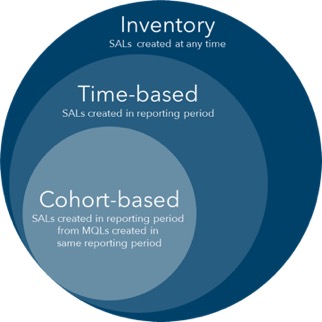
Back in 2006, SiriusDecisions launched its first Demand Waterfall framework. While the model has gone through several iterations over the years, it fundamentally tracks movement through various stages of an end-to-end buying cycle, such as Marketing Qualified Lead (MQL) and Sales Accepted Lead (SAL). All our clients have adopted some flavor of this model for their lead management frameworks to help them drive process and gain visibility.
However, many still struggle with how to measure against the model. We all know how to calculate a conversion rate from stage to stage. Assessing a count for the numerator (the following stage) and denominator (the starting stage) in that calculation, however, is often a little trickier.
Here are three ways to evaluate your Demand Funnel:
1. Inventory analysis
Answers the question: “What volume of buying cycles did we have in this stage at this moment in time?”
Inventory analysis simply compares the volume of buying cycles in a particular stage between the previous and current reporting periods. This method is the most basic; it requires no additional system development if you elect to physically snapshot your volume numbers at the start of each reporting period.
It’s important to measure this volume over time to ensure that you’re not creating a backlog of aging buying cycles. You may not need this measurement if you have good governance around Service Level Agreements, but it will highlight issues early on either way.
It’s a good way to measure change over time, but it’s not a good way to measure volume for conversion, because you’re not evaluating when those cycles entered each stage.
2. Time-based analysis
Answers the question: “How effective are we at adding new buying cycles to this stage in this period?”
This is the most typically applied method — and usually the easiest to develop. As a result, it’s the method used most by research firms that provide benchmarks for Demand Funnel metrics.
In this method, you’re counting any buying cycle that entered each stage during a specified timeframe. For example, you would count all SALs that entered that stage in Q1, regardless of when they were created as MQLs.
This technique works best if you’re just getting started with measuring your Demand Funnel, but it can also mask issues with buying cycles that have lagged in earlier stages. It can also produce uneven conversion rates when you have more cycles that count in a preceding stage than the following stage, which is very possible.
3. Cohort-based analysis
Answers the question: “How efficiently are we moving buying cycles through each stage in this period?”
Using this method, you’re counting only those buying cycles that entered each subsequent stage in the same timeframe as they entered the Demand Funnel. For example, if you’re measuring volume and conversion for Q1, you would only count SALs that entered the SAL stage in Q1 and were created as MQLs in Q1.
This type of measurement works well if you have a very short buying cycle or desire to measure the efficiency of your overall lead management processes.
By focusing on a narrow cohort, you can more confidently identify patterns of behavior and calculate representative stage-over-stage conversion rates, which in turn provides an excellent foundation for planning.

System Requirements: The date stamp
To achieve any of the three above reports, you will need to capture the date (and time, if you prefer) of when a record enters each stage in your Demand Funnel.
Most CRMs have default date stamping fields, but they are limited (e.g., a record’s Create Date and a Last Modified Date). This is fine if you create a new record for each stage in your Demand Funnel, but that’s a very unlikely situation. Generally, you will be managing through multiple stages in a single record using a Status or Stage field. You can also enable field history for those fields, but these value changes will be captured in a separate table, which may make reporting challenging.
The best solution is to snapshot a date stamp for each entry into a new stage. Workflow rules and tasks in your CRM are a requirement, and you’ll need to work with your respective teams to define those rules, based on your Demand Funnel taxonomy.
Putting it all together
As you can see in the diagram below, these three ways of counting the volume of buying cycles (in this case, SALs) relate closely: they work together to tell a complete story of what is happening in your Demand Funnel to give you maximum visibility.

Once you’ve agreed upon which method(s) you’ll use, ensure that you’re consistently measuring each stage so that your conversion calculations are accurate.
DemandGen offers a sophisticated Demand Funnel Reporting solution using a custom Salesforce object that captures all stage entry and exit date stamps for each of your Demand Funnel stages in a single record, as well as any other fields you need to snapshot for your reporting. This makes reporting exceptionally easy for all three methods above and enables you to slice the data in many ways.
 Gaea Connary, Consultant at DemandGen, focuses on helping organizations strengthen their lead management processes, lead scoring, nurturing strategy, and reporting and analysis to get the best return on their technology investment and meet their marketing objectives.
Gaea Connary, Consultant at DemandGen, focuses on helping organizations strengthen their lead management processes, lead scoring, nurturing strategy, and reporting and analysis to get the best return on their technology investment and meet their marketing objectives.
The post 3 Ways to Measure Your Demand Funnel appeared first on DemandGen.
About the Author
More Content by DemandGen























